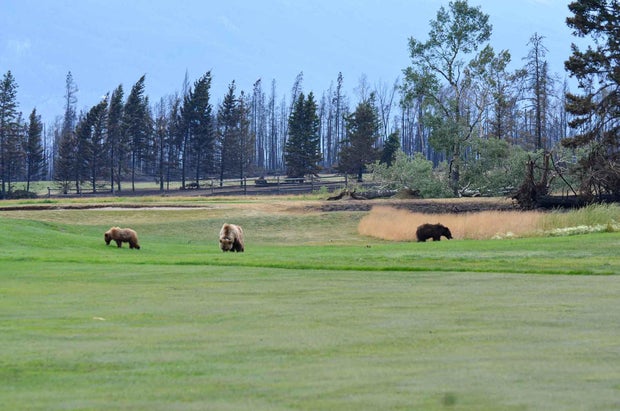See the mother bear and her cubs that survived Jasper National Park's largest wildfire in 100 years by hiding
Jasper National Park in Alberta, Canada, is facing the largest wildfire it has seen in a century. But as crews continue to race to control the flames, park officials say that there has been a glimmer of hope – a mother bear and her two cubs somehow managed to survive by hiding in place.
"In the face of flames, the extraordinary instincts of wildlife, like bears and elk, guide them to safety," Jasper National Park wrote on Facebook.
The park said that Grizzly Bear 222, who is often found around the park's lodge and is fitted with a GPS collar, found a way to save herself and her offspring "in the moments leading up to the most extreme wildfire activity" that unfolded on July 24. As of Sunday night, officials said the fire tearing through Jasper and Jasper National Park had burned an estimated 79,000 acres, about 123 square miles.
But how did the bears survive?
"[They] tucked themselves into a wet spot by the Athabasca River," the park said, adding that the mother bear continues to look "very healthy" and has been eating berries and clover.
James McCormick, a human-wildlife coexistence specialist at Parks Canada, said that despite the toll of this particular blaze, "fire is a natural process" that wild animals know how to deal with.
"We expect animals to find new places to live," McCormick said.
Photos released of the bears show one of them on July 26 – the day of their great hiding escape. That photo, which many commentators described as "heartbreaking," shows the grizzly laying over the charred remains of a tree as the forest behind is covered in black ash.
"You can see the bear's emotions of sadness, grief just like how we humans feel about what's happening there right now," one person commented on the photo.
While these bears are so far unscathed, conservationists told the Canadian Broadcasting Corporation that some species, like caribou, may face a higher toll. Tara Russell, the program director for the northern Alberta chapter of the Canadian Parks and Wildlife Society, told the CBC that of the two caribou herds that remain in Jasper National Park "don't really" have another place to go.
"There's really so little left of their habitat to maintain that resiliency to the occasional fire," she told CBC.
Deforestation and mining have reduced the species' available habitat outside of the park, she said, and could set back the park's breeding program for the species by "a number of years."
The park says on its website that "Mountain caribou depend on vast and undisturbed habitats."
"Over the last fifty years, mountain caribou herds in Alberta and British Columbia have gotten smaller in number and some herds have disappeared. Protected areas like national parks are key for their survival."
Regardless though, the park is not giving up hope on recovery.
"Amidst the ashes, life finds a way," Jasper National Park wrote on Facebook. "Just like the community of Jasper, Jasper National Park's wildlife will rebound from this crisis."





